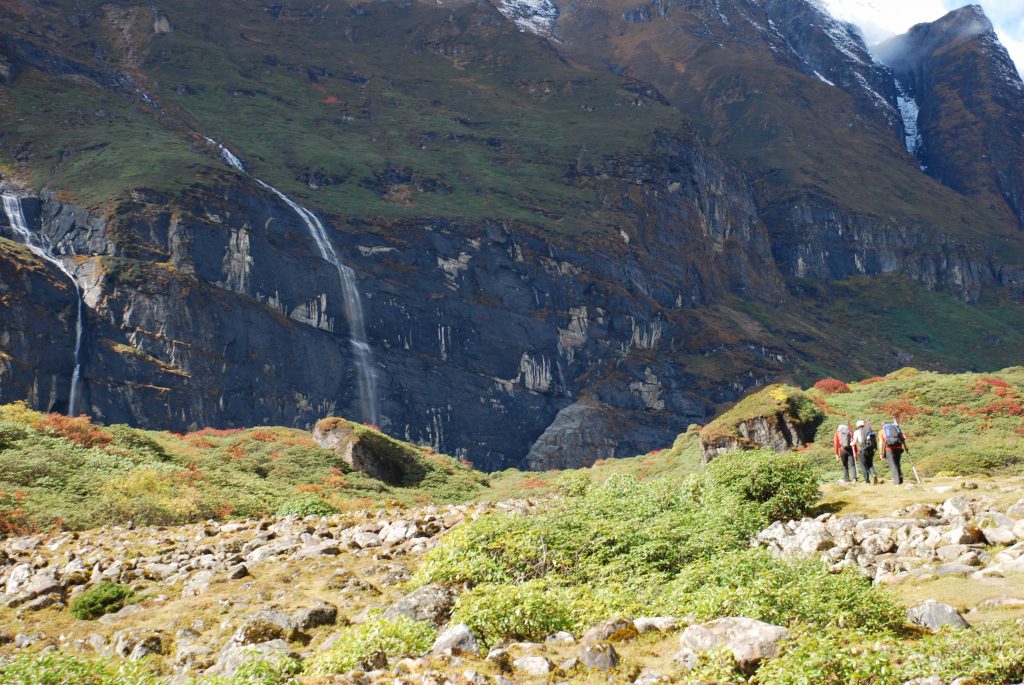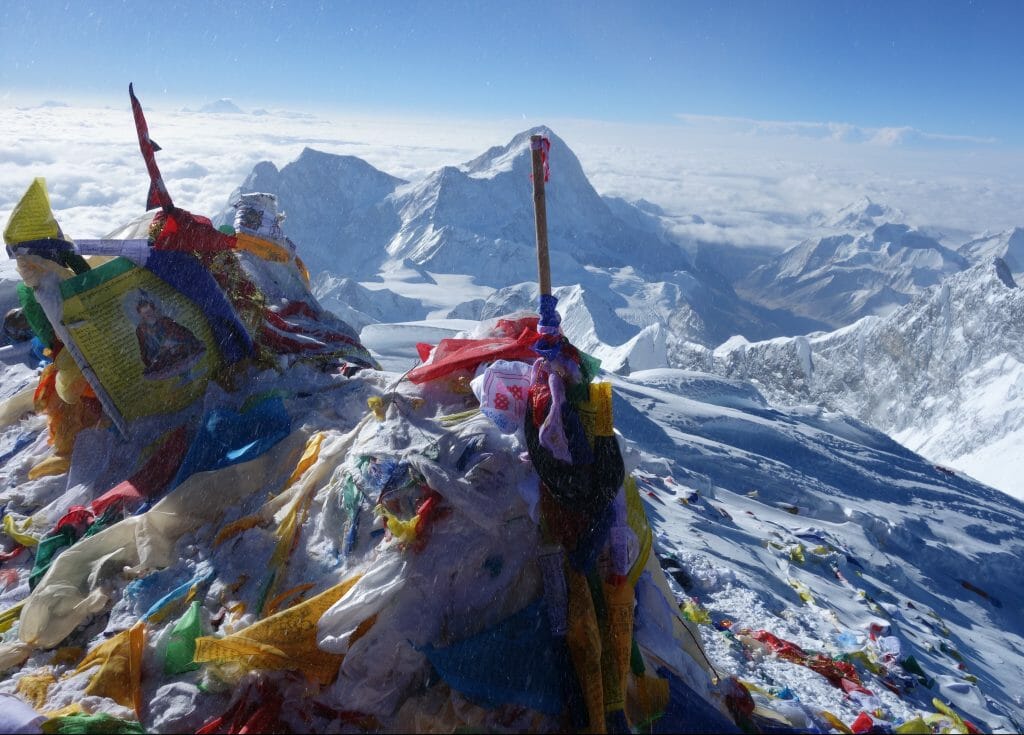A successful high-altitude expedition is dependent on many factors. Fitness is the one factor completely under your control, and we have a number of athletes heading to the Himalaya in the next couple of weeks. As climbers start their journeys, we want to share 14 key tips and recommendations for traveling to, acclimating for, and climbing in the big mountains.
The Travel
1. You are as fit as you are going to be right now.
Running (or hiking) in Kathmandu/Delhi/Islamabad is more dangerous than it is worth. What we advise is for you to relax during the travel. Pay close attention to personal hygiene, and sleep as much as you can. You’ll likely be carrying fatigue from all the hard training.
The Khumbu especially is very heavily traveled with thousands of people coming from all over the world. These people will be carrying all sorts of germs with them. Sanitation may be poor and the spread of disease there is one of the principal causes of failure to summit.
The Trek In
2. Bring hand sanitizer.
Carry a small bottle of hand sanitizer and use it frequently. Also minimize your contact with other people.
3. Do not push yourself.
Deep fatigue from the previous months of training will depress your immune system and make you much more susceptible to illness. Do not push yourself during the approach to base camp.
4. Cover your nose and mouth.
Consider wearing a surgical mask or bandana over your nose and mouth when you have to be in a tight space with a lot of strangers, especially if you notice any sick people in your immediate area. We know this is not the height of fashion, so if anyone asks, tell them you have a cold and don’t want to get others sick.
5. Do not push your pace on the daily treks to base camp.
Does this sound familiar? Again, you will not gain more fitness this way and in fact will jeopardize your health. We ask our coached athletes to wear their heart rate monitors so as to be careful not to exceed their Aerobic Threshold heart rate during the trekking days. If you don’t want to wear a monitor, simply keep your effort to a comfortable talking pace. Do not look at David Goettler’s Strava segments and become tempted to compete with his times.
6. Resist the pull to carry a heavier pack on these days.
Carry the minimum weight necessary. The less you stress yourself on these days, the easier time you will have acclimating and thus the better you will be setting yourself up for success later.
7. Have a plan for your midtrek rest day.
Ideas: restorative (very gentle) yoga; an easy, slow stroll for 30–60 minutes; completing a crossword.
8. Never run on your rest day.
9. Slow down and prepare yourself mentally.
This could be the subject of another book because best practices vary between people. Generally speaking this is the time to slow down and let go. This is a critical—maybe the most critical—part of successful expedition climbing and the big reason we are not fans of speedy approaches with helicopters and other shortcuts. In the modern era of travel, it takes time for your mind to catch up with your body. During the trek in, multiple mental processes need to shift. The first is to slow down. You’re on mountain time now. You must slow down and think in these terms. Storms take days to pass, conditions may take weeks to improve. Patience is one of the greatest virtues of an expedition climber.
As important as your own internal peace is, your connections with your partners are just as vital. Spend time making an effort to connect with those with whom you’ll be climbing. Help them pitch a tent. Go out of your way to share in the collective work of the expedition and increase your understanding and level of trust with your climbing partners. These simple things have enormous effects on the outcome of your climb.

The High-Altitude Climb: Time at Base Camp
High-altitude climbing is a game of preparation and patience. Or to put it another way, being in the right place at the right time, for the right reason. Keep in mind that, in the end, the only important days are the days leading up to summit day, summit day itself, and getting back down safely and efficiently. The weeks, or sometimes months, leading up to the summit push typically aren’t that critical and they provide numerous opportunities to fail.
10. As you acclimatize, go slow.
Your goal during the acclimatization period is to go as slowly as is reasonable. As much as possible, stay at a conversational pace. You may well experience competition among your teammates to see who carries the most weight, who gets from C1 to C2 the quickest, etc. DO NOT GET SUCKED INTO THIS. Your goal should be to a) fulfill your responsibilities to the team; b) conserve as much energy as you can; and c) have that energy on tap during the climb to and back from the summit. This means going slowly, often for many weeks. Remember how higher-intensity training results in necessarily longer recovery times? The same is true at high altitude, but the effect is magnified manyfold. Overexertion can easily doom your climb. Go slowly and carefully throughout the acclimatization period. It’s our experience that the more energy you can conserve in the first part of the expedition, the more energy you’ll have when it counts.
11. Eat well, when you can.
Most climbers share the experience that their appetites will fluctuate significantly over the course of the expedition. This is normal. Eat well, when you can. When your appetite is suppressed, you still need to force yourself to eat something—even if it’s a simple energy bar that substitutes for dinner, or a gel, or worst case, liquid calories like sugary sports drinks or recovery mixes. Some food is always better than none.
12. Prioritize sleep.
Sleep is your body’s most important recovery modality. Create a healthy sleep routine and stick to it as best you can. Get on a schedule. Relax. Read. Breathe. Try to avoid checking up on work or solving whatever problems await you back home. Mental peace is the first step to relaxing, and therefore sleeping. Consider cutting the cord on unnecessary communications. Your acclimatization and endurance capacity will benefit greatly from improved sleep. Remember to avoid sleeping pills that act as respiratory depressants, which include most popular prescription sleeping medications. Melatonin is a natural, proven, and safe sleep aid.
13. Do not train on your days off in base camp.
There will be considerable inactivity during this trip. Much more than you are normally used to at home. That is part and parcel of high-altitude climbing. Besides allowing time for acclimatization, there will be weather days. You cannot speed the process of acclimatization and you can’t improve your fitness once this trip starts. Do not “train” on your rest days. This is very bad idea. If you are restless, do gentle yoga or take a walk. Do not engage in vigorous exercise in hopes of slowing the inevitable decay of your fitness. The reason you have engaged in a prolonged training program is to have your fitness bank account as large as possible so you can be making withdrawals from it for many weeks without fear of bouncing any checks.
14. Breathe steam.
One of Steve’s favorite base camp pastimes is breathing steam. Set up a large pot of hot water, place your face over it, place a towel over your head, and breathe! Start by inhaling through your mouth and exhaling through your nose. The goals is to clean and moisturize your often-dry sinuses. Above base camp, Steve carries a tiny bottle of saline nasal spray for the same purpose. Keeping your sinuses clean and open helps keep you healthy as well as improves your breathing and sleeping.

Putting It All Together
Minimizing your chances of becoming ill, going slowly, sleeping a lot, and being patient are simple, tried-and-true ways to ensure that you get to put your hard-earned fitness to the test on your high-altitude climb. Finally, remember the time-tested maxim of successful of expedition climbing:
First: Come back safe.
Second: Come back friends.
Third: Get to the summit.
Best of luck. We’re pulling for you!
Originally published 9 April, 2018.

